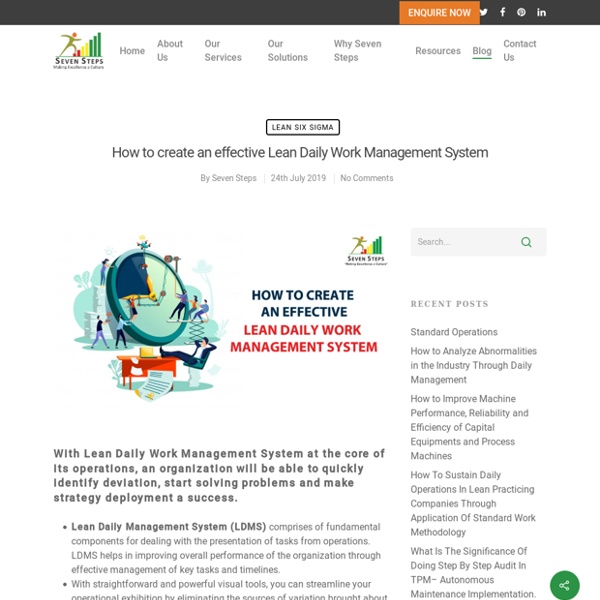Lean in Hospitals & Healthcare Services
Hospitals are a key part of health care delivery system. They provide a variety of services ranging from outpatient treatment to admissions and rehabilitation. As a system, hospitals are intricate network of processes. Starting from the reception to the admissions and discharge office, the entire work is a series of processes.
Lean Manufacturing in Garment Industry
The Lean Manufacturing concept in the Apparel Industry can diminish the operational expense in manufacturing by wiping out the process waste, engaging individuals with more prominent communication, expanding the higher efficiency in the execution procedure and transforming the company into a learning organization. Lean Manufacturing is a precise methodology for accomplishing the shortest possible cycle time by eliminating the process waste through continuous improvement. In this way making the activity productive and just comprising of value adding steps from beginning to end. In simple words lean is manufacturing without waste. Key requirements for success of Apparel operations What is Lean Thinking ?
Bouncing Back After COVID 19- 4Cs Which Will Drive Business Results Through Business Excellence
Four Cs which will drive Business results through Business Excellence. One of them is not Covid-19! Yes!
Phases of Lean Transformation
Lean is a way of thinking. It is a journey that is never over. It is a system framed in a collection of rules and principles. Current conditions and criteria must be examined. Some of the following 10 criteria may be more important than others to consider at the different phases of lean transformation. 1.
How Lean Manufacturing will help to improve Productivity
Lean is the term which has core philosophy of doing more and more with less and less. Lean System can also be referred as FIT without Fat. Origin of Lean is from Manufacturing set up in Japan which had always valued its scare resources which is primarily space. Thought process on working with less space happened when Taiichi Ohno, the then shop-floor supervisor of engine manufacturing plant went to his boss and asked for more space to store inventory. Having already reeling under less resources of money and space, Taiichi Ohno was asked to explore how the inventory can be reduced so that it needs less space.
Standard Operations- Need for Standard Operations
What is the Need for Standard Operations? It happens that the most important elements in the daily activity of manufacturing begin with the letter “M.” In factories, we are trying to find the best possible combination of Men, Materials, Methods, Measurements, and Machines, so that we can make the best products while spending less cost.
Best practices of Operational Excellence Journey Methodologies
Our answer is yes. Every tool/methodology has unique features that helps for every business. Seven Steps Business Transformation is in the field of helping organisations in their Journey of Excellence. As combination of business excellence and operational excellence, every company where we have helps got substantial benefits and improvement in their overall performance. Quite often, we come across industry leaders who ask a common question … “will this particular tool/methodology will be applicable for us”. Having worked with hundreds of organisations and multiple business sectors, we find that adapting best practices of all methodologies will certainly give edge in results.
Lean Layouts and Cellular Manufacturing
Traditionally, many conventional factory design had common manufacturing method of Job shop which is organised based on the concept where all similar operations are grouped and put in one room with a supervisor or a manager. High batch size, high volume transportation, high need for storage space and aisles/pathways flooded with materials resulting safety compromise. Factory design in the form of Lean layout with cellular manufacturing concepts helps in improving productivity, reduction of Lead time, improves Quality and improves ontime performance.
Implementation of Total Productive Maintenance
Total Productive Maintenance is well known in its abbreviated form – TPM has origins from Japan. It is a well structured and scientific method refined with many iterations for getting best and sustainable results. TPM is not only for machine intensive organisation.
Lean Transformation Roadmap
Time Frame : Dependent on Variables Results At the end of Phase Three, an organization is building upon already-found gains. It is experiencing major breakthroughs and its performance is moving forward at a constant pace. When an organization reaches Phase Four, there is some danger it may fail to recognize lean is a journey that is never complete.
TQM,TPM,LEAN,SIXSIGMA: Right strategy for organization’s business excellence journey
1.0: The need for Business Excellence Journey? There are four Cs which drive organization for Business Excellence. Competition, Customer, Company/CEO Vision and Crisis.
Objectives of Jishu Hozen (Autonomous Maintenance)
Life of equipment depends not only on how well it is used but also on how well it is maintained. Various versions of maintenance techniques are in use. Total Productive Maintenance popularized by Japanese is one of the best methodology used worldwide
Implementing the 5S Methodology, Visual management systems
Before implementation of Visual management, implementation of 5S is highly recommended. Seven Steps Business Transformation systems uses a unique methodology called Applied 5S which is very unique way of implementation with Total Employee involvement. What is 5SWhat is the difference between Cosmetic and Function 5S (Applied 5S)Need for 5SOur Services for 5SOur Methodology and Case StudiesList of Customers
Standard Work Methodology- How To Sustain Daily Operations In Lean Practicing Companies
Standard work is one of the fundamental Lean tool for defining the best combination of man and machine activity for the best productivity. It consists of timing for different elemental activities, the path to be followed by the operator in doing the activities. Standard work has 3 elements: Takt timeStandard sequence for doing the workWork In Process to produce products without any stockout situations Takt time is the time within which the product to be produced to meet the customer demand.



